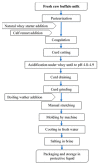Chemical Characteristics and Oxidative Stability of Buffalo Mozzarella Cheese Produced with Fresh and Frozen Curd
- PMID: 33807744
- PMCID: PMC7961936
- DOI: 10.3390/molecules26051405
Chemical Characteristics and Oxidative Stability of Buffalo Mozzarella Cheese Produced with Fresh and Frozen Curd
Abstract
Milk and dairy products can have variable contents of antioxidant compounds that contribute to counteract the oxidation of lipids and proteins during processing and storage. The content of active antioxidant compounds is closely linked to their protection by oxidation. Freezing is one of the factors that can reduce antioxidant activity. Freezing of milk or curd is frequently used in case of the seasonality of milk production and/or seasonal increased demand for some products. In this paper, the effect of using frozen curd on the oxidative stability of buffalo Mozzarella cheese was evaluated. Samples of buffalo Mozzarella with different frozen curd content (0%, 5%, 20%, and 50%) were produced and analyzed at one and nine days. Mozzarella cheese with higher frozen curd content had a significant increase in redox potential parallel to the decrease in antioxidant activity, showing less protection from oxidation. Lipid and protein oxidation, expressed respectively by malondialdehyde and carbonyl content, increased significantly with increasing frozen curd. At nine days, carbonyls significantly increased while malondialdehyde content did not vary, showing that during storage, fat was more protected from oxidation than protein. The average carbonyl levels were comparable to those of some cooked cheeses, and the malondialdehyde levels were even lower. The results of this study stimulate the investigation of new strategies to decrease the oxidative damage in cheeses produced in the presence of factors decreasing oxidative stability.
Keywords: MDA; antioxidant activity; carbonyls; lipid oxidation; protein oxidation.
Conflict of interest statement
The authors declare no conflict of interest.
Figures





Similar articles
-
Identification of protein markers for the occurrence of defrosted material in milk through a MALDI-TOF-MS profiling approach.J Proteomics. 2016 Sep 16;147:56-65. doi: 10.1016/j.jprot.2016.02.016. Epub 2016 Feb 22. J Proteomics. 2016. PMID: 26910555
-
Effect of homogenization on the properties and microstructure of Mozzarella cheese from buffalo milk.Acta Sci Pol Technol Aliment. 2012 Apr 2;11(2):121-35. Acta Sci Pol Technol Aliment. 2012. PMID: 22493155
-
Influence of milling pH and storage on quality characteristics, mineral and fatty acid profile of buffalo Mozzarella cheese.Lipids Health Dis. 2019 Jan 29;18(1):33. doi: 10.1186/s12944-019-0976-9. Lipids Health Dis. 2019. PMID: 30696457 Free PMC article.
-
Freezing as a solution to preserve the quality of dairy products: the case of milk, curds and cheese.Crit Rev Food Sci Nutr. 2021;61(20):3340-3360. doi: 10.1080/10408398.2020.1798348. Epub 2020 Jul 25. Crit Rev Food Sci Nutr. 2021. PMID: 32715725 Review.
-
Ice crystallization and structural changes in cheese during freezing and frozen storage: implications for functional properties.Crit Rev Food Sci Nutr. 2025;65(3):527-550. doi: 10.1080/10408398.2023.2277357. Epub 2023 Nov 16. Crit Rev Food Sci Nutr. 2025. PMID: 37971852 Review.
Cited by
-
Effect of Packaging and Portioning on the Dynamics of Water-Fat Serum Release from Fresh Pasta Filata Soft Cheese.Foods. 2022 Jan 22;11(3):296. doi: 10.3390/foods11030296. Foods. 2022. PMID: 35159448 Free PMC article.
-
Stability and Biaxial Behavior of Fresh Cheese Coated with Nanoliposomes Encapsulating Grape Seed Tannins and Polysaccharides Using Immersion and Spray Methods.Polymers (Basel). 2024 May 31;16(11):1559. doi: 10.3390/polym16111559. Polymers (Basel). 2024. PMID: 38891503 Free PMC article.
-
Antimicrobial and antioxidant activities of water-soluble extracts of Camis cheeses produced by different traditional methods.Food Sci Nutr. 2024 Jul 2;12(9):6699-6710. doi: 10.1002/fsn3.4305. eCollection 2024 Sep. Food Sci Nutr. 2024. PMID: 39554343 Free PMC article.
-
The Role of Autochthonous Levilactobacillus brevis B1 Starter Culture in Improving the Technological and Nutritional Quality of Cow's Milk Acid-Rennet Cheeses-Industrial Model Study.Foods. 2024 Jan 25;13(3):392. doi: 10.3390/foods13030392. Foods. 2024. PMID: 38338527 Free PMC article.
-
Aloe barbadensis Based Bioactive Edible Film Improved Lipid Stability and Microbial Quality of the Cheese.Foods. 2023 Jan 4;12(2):229. doi: 10.3390/foods12020229. Foods. 2023. PMID: 36673321 Free PMC article.
References
-
- Commission Regulation (EC) No 1107/96 of 12 June 1996 on the registration of geographical indications and designations of origin under the procedure laid down in Article 17 of Council Regulation (EEC) No 2081/92. J. Eur. Union. 1996;148:1–10.
-
- CLAL-Italia: Produzioni di Formaggi DOP. [(accessed on 18 February 2021)]; Available online: https://www.clal.it/index.php?section=formaggi_dop.
-
- Fedele E., Bergamo P. Protein and lipid oxidative stresses during cheese manufacture. J. Food Sci. 2001;66:932–935. doi: 10.1111/j.1365-2621.2001.tb08214.x. - DOI
-
- Balestrieri M., Spagnuolo M.S., Cigliano L., Storti G., Ferrara L., Abrescia P., Fedele E. Evaluation of oxidative damage in mozzarella cheese produced from bovine or water buffalo milk. Food Chem. 2002;77:293–299. doi: 10.1016/S0308-8146(01)00347-8. - DOI
-
- Unal G. Antioxidant activity of commercial dairy products. Agro Food Ind. Hi Tech. 2012;23:39–42.
MeSH terms
Substances
LinkOut - more resources
Full Text Sources
Other Literature Sources
Medical

